Humanity has long been preoccupied with building towers that give the illusion of reaching the heavens. The Biblical story of the tower of Babel is one of humankind’s earliest recorded attempts to construct a way to access these celestial heights.
Ancient cultures such as the Sumerians, Egyptians and Mayas built complexes that featured towering structures which were used for ceremonial purposes and as astronomical observatories.
The term ‘skyscraper’ was first coined in the late 19th century to describe buildings over ten stories high which were being constructed over steel frames in Chicago and New York.
Today, cities all across the globe are recognized by these phallic spires that mingle with the clouds, projecting a sense of economic dynamism on the one hand, while on the other, thumbing their noses at the natural world.
Above all else, skyscrapers are symbols of wealth, power and humankind’s domination over nature. Just as contemporary global cities jostle for the superlative of having the world’s tallest building, ancient cities used building height to project a similar sense of strength and dominance.
Medieval towers
In the 12th and 13th centuries, the city of Bologna, in what we know today as northern Italy would surely have deserved the title of the world’s skyscraper capital. While the number of tall structures in medieval Bologna is still a matter of debate, most reputable sources estimate there were at least one hundred towers dotted around this bustling city.
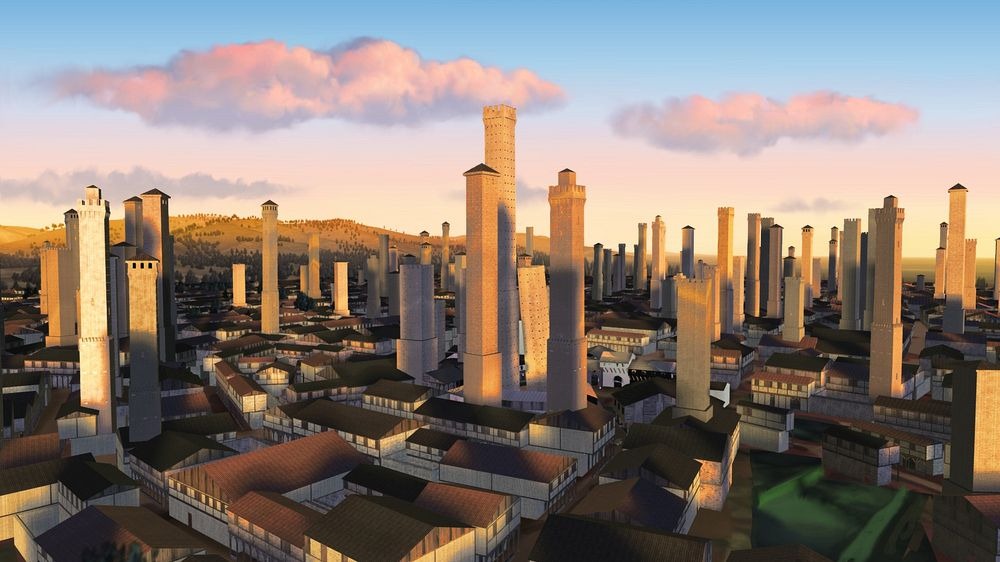
Artist’s conception of Bologna as it might have looked in the 12th and 13th centuries with its scores of towers spread across the cityscape. Photo Credit: : https://www.cineca.it
As is true of other Italian city-states of this period, there was a great deal of competition between wealthy families as they vied for power and control over land. Bologna’s towers were presumably built as iconic displays of superiority over one’s rivals. They also gave military advantage and were used to watch over each family’s land holdings.
These engineering marvels were built out of bricks, wood and stone and soared hundreds of feet into the air centuries before the manufacture of steel beams made modern skyscrapers possible. Of the more than one hundred towers, only twenty-four remain standing in Bologna today.
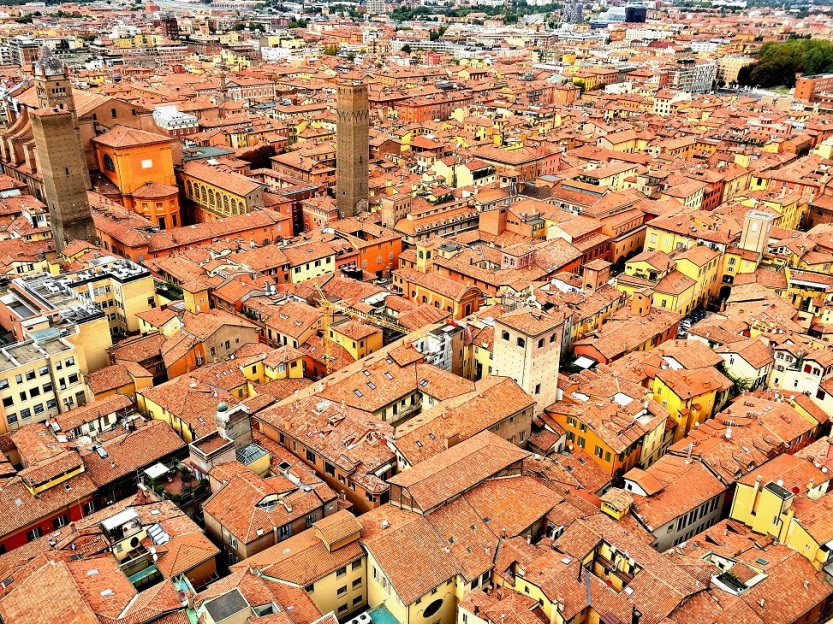
View of Bologna’s historic center from the top of the city’s tallest surviving medieval tower. The Bascillica of Saint Petronius, which once claimed to be the world’s largest church, can be seen on the left, flanked by more leaning medieval towers. Photo Credit: Henry Lewis
Due Torri (two towers)
The skyline of today’s Bologa is dominated by the two tallest of the city’s surviving towers. The Torre degli Asinelli is the tallest leaning medieval tower in the world, standing 97.2 meters (319 feet), while its little sister, the Garisenda Tower, is 48 meters high (157 feet).
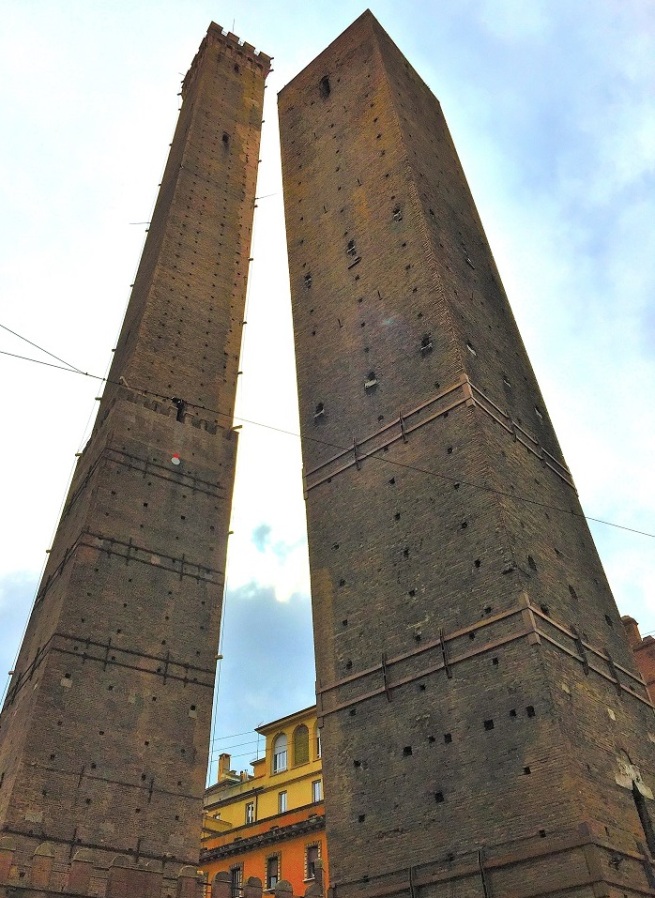
The Asinelli Tower on the left with its little sister, the Garisenda Tower, on the right. Both are located in the heart of Bologna’s historic center. Photo Credit: Henry Lewis
The Asinelli Tower, built between 1109 and 1119, has seen its share of history. Over the centuries, there have been at least two documented large fires, plus the building has been struck by lightening multiple times. In fact, a lightening rod wasn’t installed on top of the tower until 1824.
The Asinelli Tower is open to the public and the incredible views of the city from the narrow viewing platform at the top can be enjoyed after climbing 498 steps up an ancient wooden staircase. As one ascends the staircase, there’s plenty of time to marvel at the construction techniques used to attain such a height 900 years ago.

Statue of Saint Petronius, the patron saint of Bologna, framed by the Garisenda Tower (L) and Asinelli Tower (R). Photo Credit: Henry Lewis

The Asinelli Tower with its green dome and lightening rod visible. Photo Credit: Henry Lewis
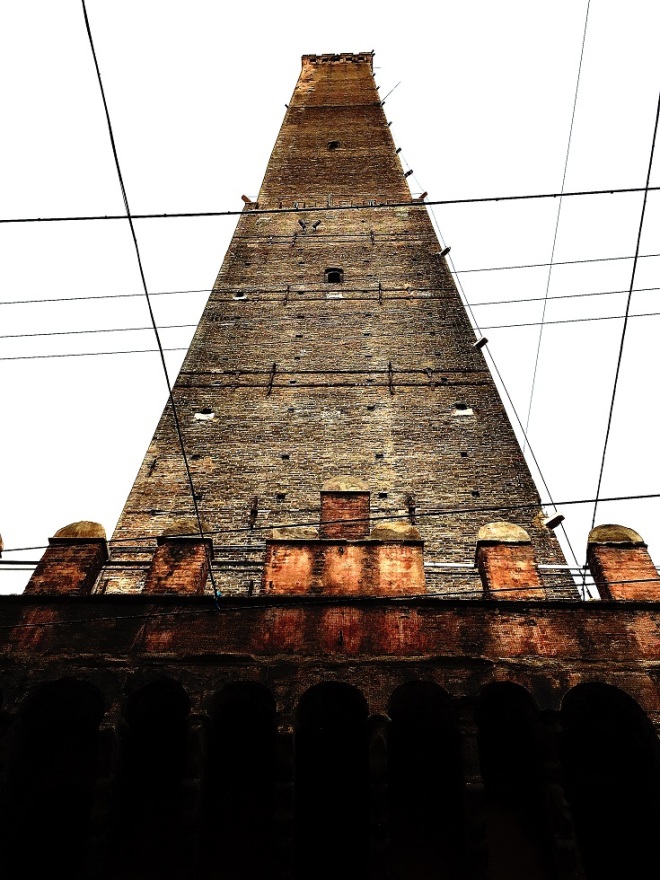
View standing at the base of the Asinelli Tower. Photo Credit: Henry Lewis
Or perhaps, it’s best to simply observe one’s feet as you ascend all those steps and not contemplate how easily the entire structure could collapse. After all, most areas of Italy are seismically active. 😉
Inside the Asinelli Tower
If you share my fascination of construction methods, especially partially crumbling ancient structures, you’ll love the interior of the Asinelli Tower. Remember that the tower has been partially rebuilt many times over the centuries which allows rich layers of history to be revealed.
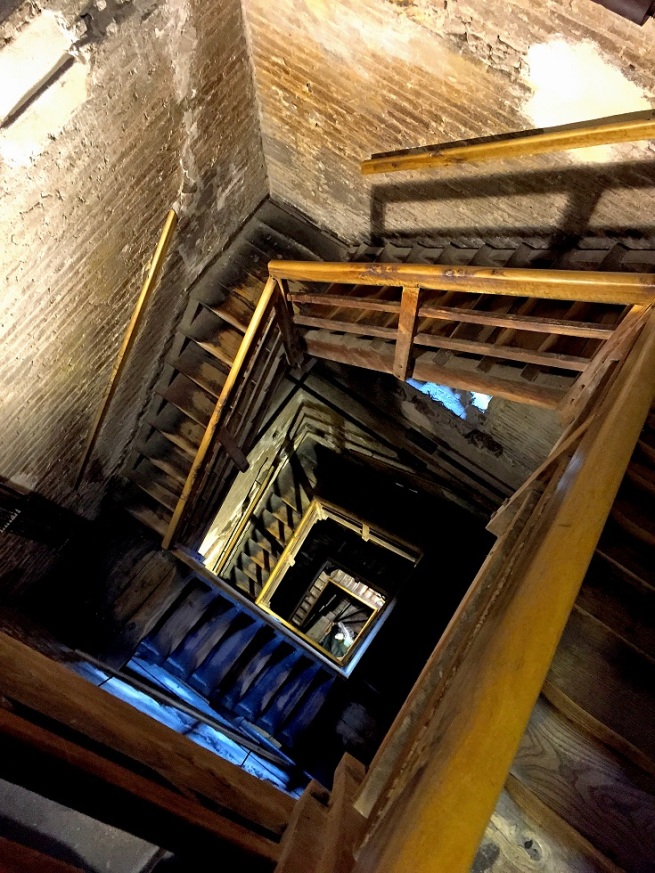
Looking down the wooden staircase about 2/3 way up the Asinelli Tower. Photo Credit: Henry Lewis
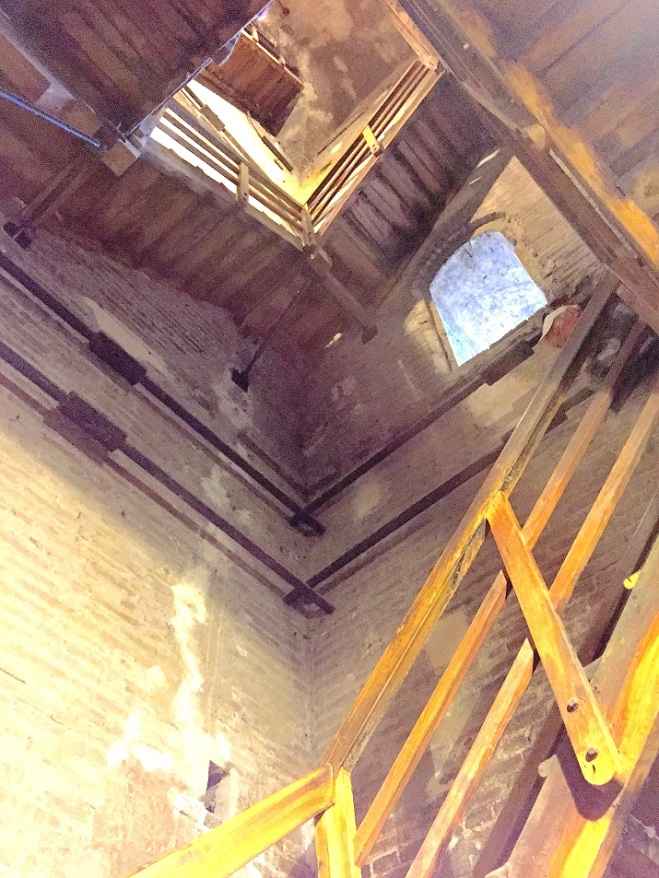
Looking up the staircase inside the Asinelli Tower, almost to the top. Photo Credit: Henry Lewis

The final flight of stairs to the top of the Asinelli Tower and the doorway to the observation platform. Mind your head; people were considerably shorter in centuries past. Photo Credit: Henry Lewis
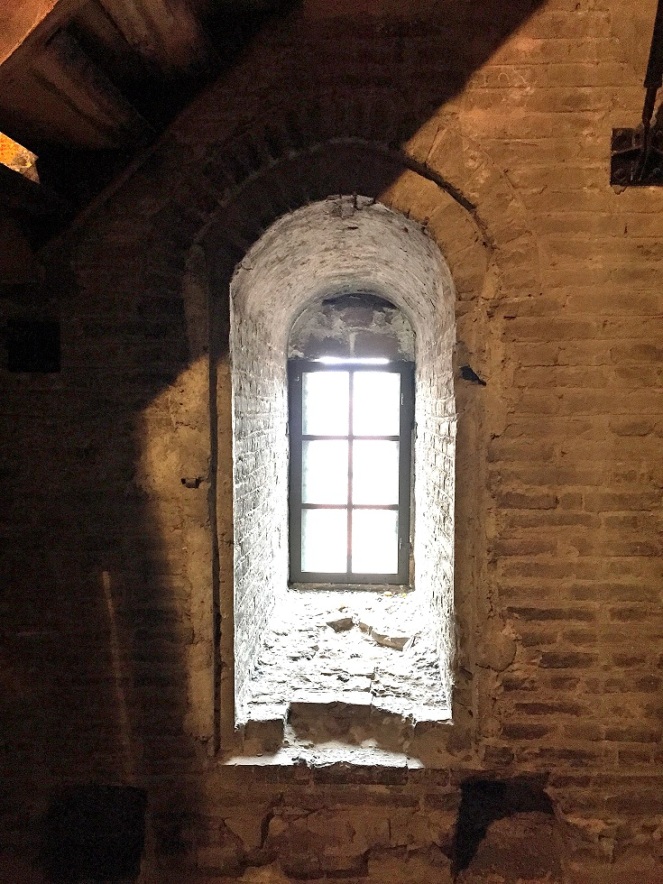
One of many windows along the stairway to the top of the Asinelli Tower. Photo Credit: Henry Lewis
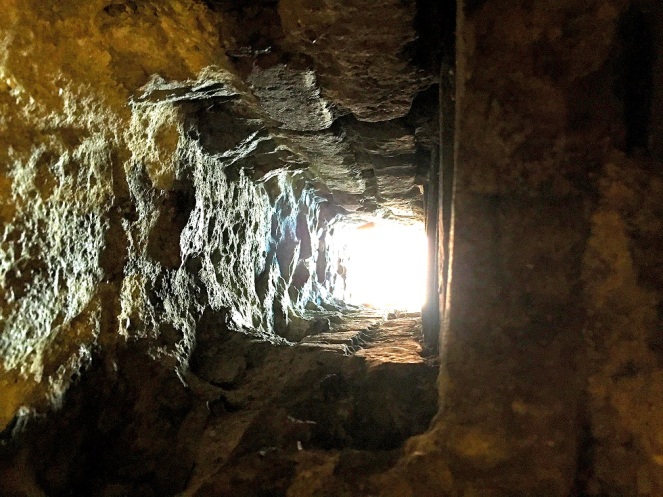
View of the wall thickness inside the Asinelli Tower. Photo Credit: Henry Lewis

A patched–but still crumbling–brick arch support inside the Asinelli Tower. Photo Credit: Henry Lewis
Don’t be a wimp
While I was enjoying the panoramic view from the top of the Asinelli Tower, a man who must have been in his 80s, walking with a cane, arrived at the viewing platform. The human spirit is truly amazing! I had to congratulate him on his triumph!
And Finally
If tower gazing and stair climbing aren’t your cup of tea, Bologna is also renowned for the world’s oldest university, miles of architecturally interesting covered porticoes–so you’ll never worry about the weather–and some of the best Italian food to be found anywhere.
Bellissima!
peace~henry
Header Image Credit: Toni Pecoraro/Wikimedia



Very interesting. As a physicist, I was amazed at their height using those materials. I assume earthquakes took down many along with faulty design.
Then there is gravity and dropping objects to observe acceleration. 🙂
LikeLiked by 1 person
It seems there isn’t much documentation from the period, but in many ways, building such narrow towers with ‘primitive’ technology and materials was totally experimental in the 12th and 13th centuries. I assume many structures would have collapsed during the initial building process (as well after), probably dooming many of the workers.
LikeLike
What an entertaining and informative piece of history and human accomplishment! Beautiful, evocative photos.
Thank you Henry. Fancy a return trip and another climb?
LikeLiked by 1 person
Hi Marios,
Actually, I’d love to return to the Bologna region. Due to work constraints, I only had time to scratch the surface. There’s so much art and history to explore there.
LikeLike
Loved the “perspectives” of all the photos!
LikeLiked by 1 person
Thanks for saying that.
LikeLike
They’re amazing, but also out of proportion and absurd looking. Maybe over-awing all and sundry leads us all to loose our sense of proportion.
Your photos do really give me a sense of the construction. Thanks for that.
LikeLiked by 1 person
I think being out of proportion and over-awing was the main point of building the towers, so they did accomplish their objective. Humans will go to such great lengths to impress and intimidate others. Thanks for commenting Ellen!
LikeLiked by 1 person
Great photos and a fascinating summary of our human attraction to heights.
LikeLiked by 1 person
Thanks Kim!
LikeLike
Marvelous history and photography! It’s also quite amazing that some of these unreinforced masonry and stone structures have survived this long in such a seismically active region. That these tall towers are phallic symbols is pretty obvious, I think.
LikeLiked by 1 person
Hi Robert,
Yeah, male architects and corporate executives love waving their dicks in the air it seems. As far as stability is concerned, I must admit I was happy when I arrived back at ground level once again.
LikeLiked by 1 person
🙂
LikeLike
Intriguing city. The 80-year-old man with the cane did well in climbing to the top!
LikeLiked by 2 people
Hi Rosaliene,
People like the 80-year-old man with the cane are my idols! I’ve wondered how he must have felt after descending the 498 steps which is much more difficult and taxing on knees etc.
LikeLiked by 2 people
A fascinating and informative historical blog post.
LikeLiked by 1 person
Thank you Dracul!
LikeLiked by 1 person
VERY INTERESTING – AND THE PHOTOS – HEIGHTS NOT NECESSARILY MY THING – BUT LOVE THE VIEWS IF I DON’T LOOK DOWN.
LikeLiked by 1 person
I don’t think you would have liked the staircase inside the Asinelli Tower. 😉
LikeLike
My dad just turned 80. He’d be up there with no cane! Amazes me. The smaller tower looked a little like a minaret, I thought. Like La Giralda in Sevilla. Thanks for the virtual tour of Bologa! -Rebecca
LikeLiked by 1 person
Hi Rebecca,
Good for your Dad! I hope I don’t lose my sense of adventure by the time I reach that age–if I in fact do, considering my penchant for accidents.
LikeLiked by 1 person
Stay safe and have many happy travels for decades. : )
LikeLiked by 1 person
Thanks. You too!
LikeLiked by 1 person
That was fascinating, and thank you for the fab shots!
LikeLiked by 1 person
Thank you Resa!
LikeLiked by 1 person
I love the pictures, I was once in Bologna but never made the climb… your article brings in me fond memories of the city! Next time you go to Italy (maybe you know it already) go to San Gimignano near Sienna, it is a small city with numerous towers.
LikeLike
I never made it to San Gimignano, but would love to go. Have you created art based on the towers there? If so, I’d love to see it. 🙂
LikeLike
I have not made anything with San Gimignano in mind. I was there 35 years ago and only for an afternoon. As I rely oftenly on photographs to work, I had not enough of them to inspire me… Today, with Internet it is quite easy to find anything as many photographs as you want, but that was not the case in the 80s! But maybe one day, an idea will pop up…
LikeLiked by 1 person
Reblogged this on From 1 Blogger 2 Another.
LikeLiked by 1 person
Thank you Douglas!
LikeLike
Thanks for the reblog!
LikeLike
I’ve passed through Bologna airport several times (my wife’s family live fairly near), but I’ve never got to check out the towers. You’ve whet my appetite- maybe next time we visit we’ll go 🙂
LikeLiked by 1 person
You definitely should try to make time to see Bologna’s towers, but also the entire historic center. Thanks for commenting!
LikeLiked by 1 person
I was immediately struck by how the artists conception of Bologna is mirrored today by the condo towers being constructed in residential neighbourhoods.
LikeLiked by 1 person
Hi June,
The artist’s conception of medieval Bologna does mirror today’s cities. It must have been quite a sight for people approaching the city back in that day. Thanks for stopping by!
LikeLiked by 1 person